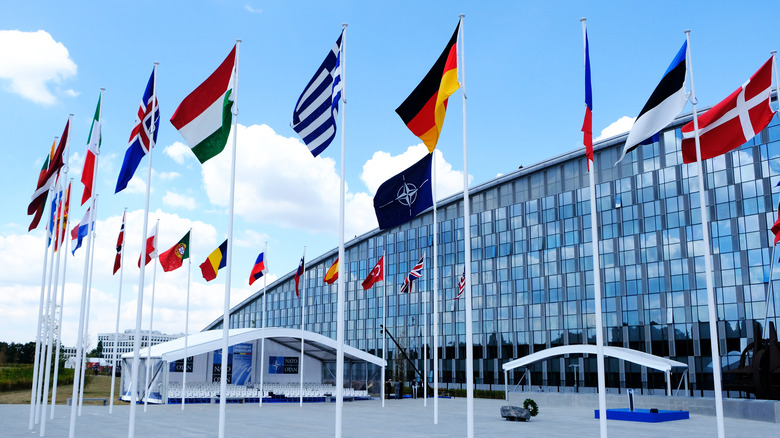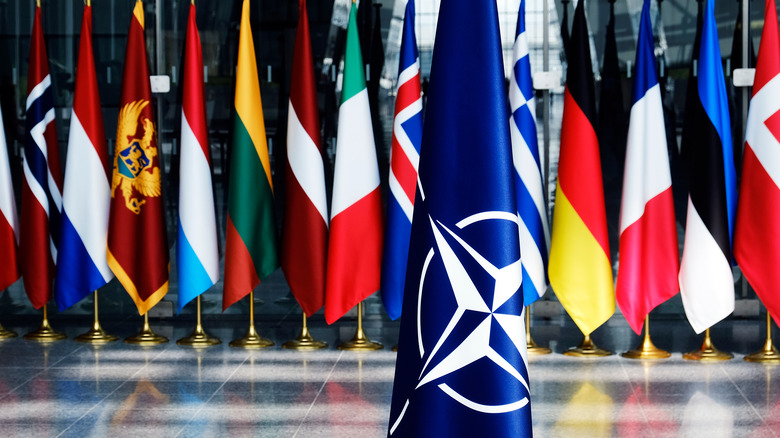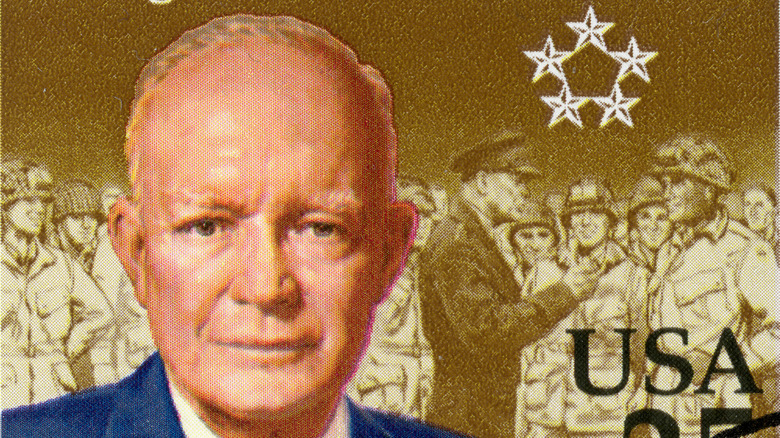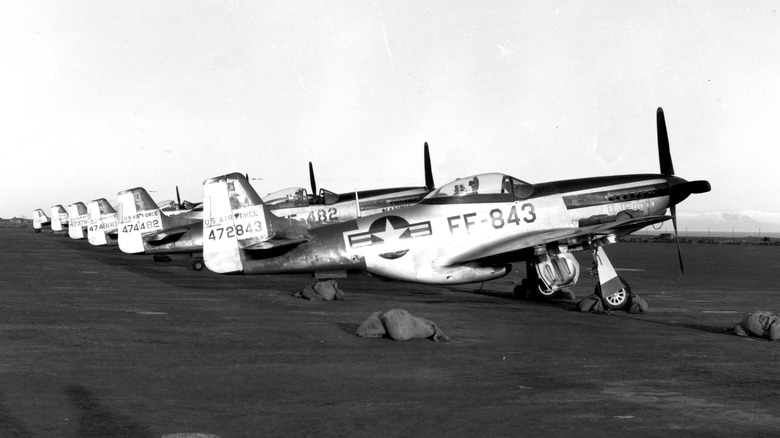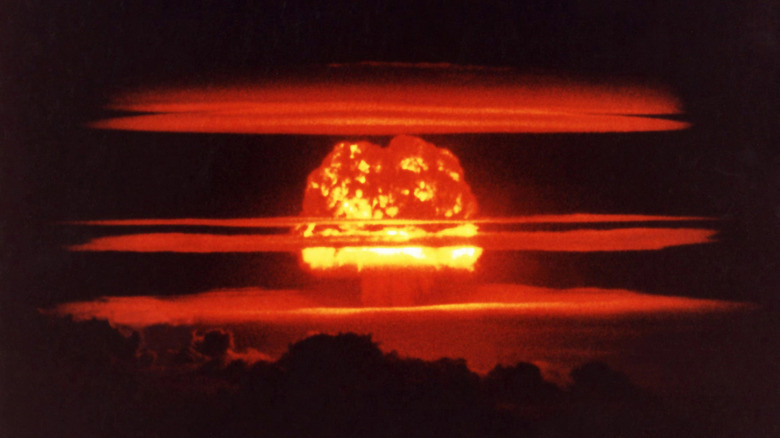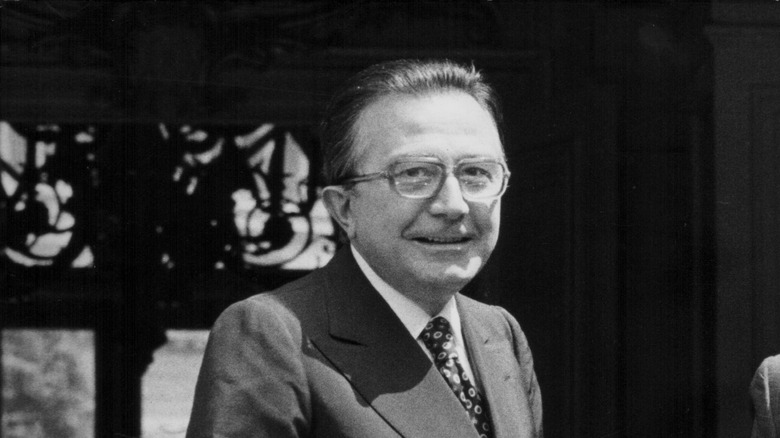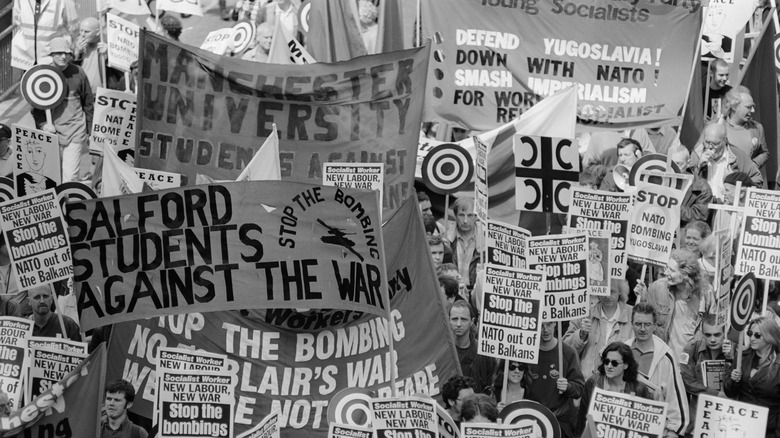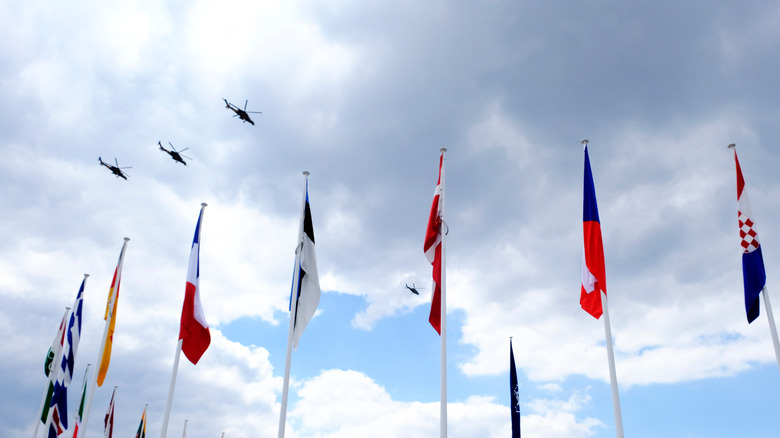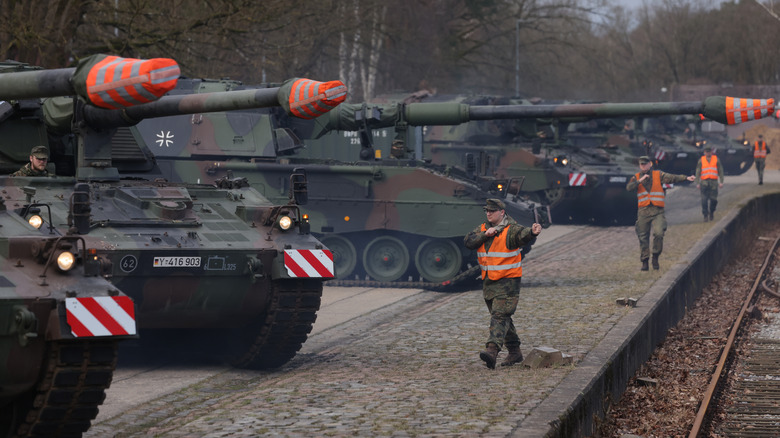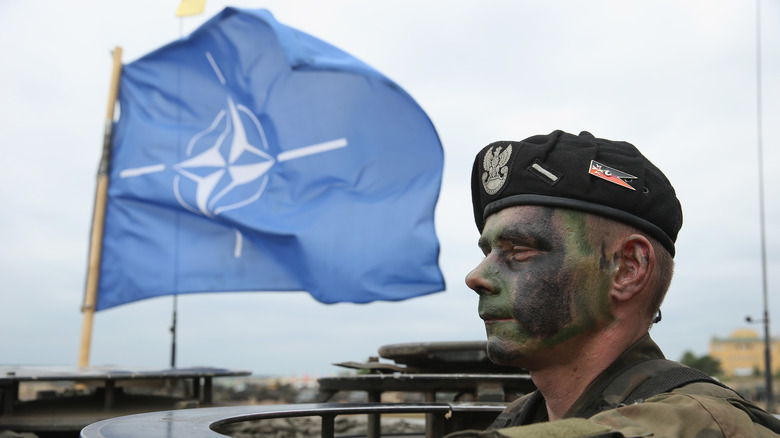The Untold Truth Of NATO
During the Cold War, NATO operated with the principle of mutual defense towards deterring and resisting Soviet expansion after World War II. After the fall of the Soviet Union in 1991, NATO survived with a little bit of rebranding and has continued to maintain a presence in Europe.
It can take a country up to 20 years to complete the application process to join NATO and NATO members have to unanimously agree to the new country's membership, but NATO membership is open to any country, as long as they "meet certain political, economic and military goals in order to ensure that they will become contributors to Alliance security as well as beneficiaries of it." As of February 2022, NATO recognizes Bosnia and Herzegovina, Georgia, and Ukraine as aspiring members.
Meanwhile, NATO has also been criticized for its expansionism and former President Donald Trump even talked about withdrawing from NATO. But before deciding if NATO is a worthwhile military pact, it's worth knowing a little bit about how it works and what it's been up to over the years. This is the untold truth of NATO.
What is NATO?
The North Atlantic Treaty Organization, also known as NATO, was created on April 4, 1949, when the United States, the United Kingdom, France, Italy, Belgium, Canada, Denmark, Iceland, Luxembourg, the Netherlands, Norway, and Portugal came together in Washington, D.C. in the United States four years after the end of World War II to sign the North Atlantic Treaty, also known as the Washington Treaty. According to The Guardian, the treaty was a military pact intended to be a "shield against aggression and the fear of aggression." And this potential aggression was emphasized as being specifically "Soviet aggression," writes TIME Magazine.
David M. Andrews notes in "The Atlantic Alliance Under Stress" that Hastings Ismay, the very first Secretary-General of NATO, stated that the purpose of NATO was to "keep the Russians out, the Americans in, and the Germans now." Although this statement is a simplification, each aspect was dependent on the other and all were considered to be a significant part of the NATO mission.
As of 2022, there are 30 member states of NATO and after the collapse of the Soviet Union, NATO's mission was redefined to involve "ensur[ing] the democratization of newly post-communist republics." However, as the Brookings Institution notes, the American perspective is that "NATO has the right to use force whenever the interests of its members so require."
Appointing the Supreme Commander
Supreme Allied Commander Europe (SACEUR) is one of NATO's two strategic commanders and in December 1950, General Dwight D. Eisenhower became NATO's first SACEUR. The second strategic commander is the Supreme Allied Commander Transformation (SACT). But according to NATO, although the SACT is proposed by a NATO member country and approved by NATO's North Atlantic Council, the SACEUR is "appointed by the U.S. President, confirmed by the U.S. Senate, and approved by the North Atlantic Council."
Atlantic Council notes that as of 2022, the SACEUR has always been an American officer, despite there having been repeated calls throughout the years to appoint a non-American. According to "America and Europe," edited by David C. Gompert and F. Stephen Larrabee, "it is hard to argue that NATO satisfies all European security needs when the senior officer is invariably an American, irrespective of the relative U.S. and European force contributions."
NATO Watch writes that one of the reasons that the United States always appoints an American as the SACEUR is because "Current U.S. military doctrine is that, while its forces may be placed under foreign command, they are never placed under foreign operational control." NATO Watch also notes that the Security General of NATO, one of the top diplomatic posts, is also always a European, and questions whether "a U.S. diplomat as Secretary-General and a European SACEUR [would] lead to a more balanced outlook within the alliance."
52% of world military spending
Although NATO doesn't technically have an army of its own on hand, its army exists through the militaries of all member countries. In 2017, the total military spending of 29 NATO member countries was $900 billion, "accounting for 52% of world [military] spending," according to the Stockholm International Peace Research Institute. This number has only grown over the years, with 12 NATO member countries spending 2% or more of their GDP on their military in 2020; 2% of the GDP is considered to be the guideline spending target for NATO.
The fact that the 30 member countries of NATO spend more on militaries than the other 165 countries of the world combined has more to do with the fact that the United States has an incredibly high military budget. "As the world's largest military spender, the USA accounted for 39% of total military expenditure in 2020."
No standing army
While some NATO member countries like the United States have a military budget of hundreds of billions of dollars, one NATO member country spends $0.00 annually on the military. Unlike the rest of the NATO member countries, Iceland doesn't actually have a standing army. However, according to "The Military Balance 2021" by The International Institute for Strategic Studies, Iceland makes financial contributions to NATO and has occasionally "deploy[ed] civilian personnel to NATO missions."
After World War II, the United States wanted to build a NATO base in Iceland but they were unable "to persuade the Icelandic Government to conclude a base lease agreement and had to settle for landing rights for military aircraft en route to Europe." It wouldn't be until the Korean War in the 1950s that Iceland allowed a permanent military base to be built. And at the time, "the U.S. military base in Iceland was the most hotly contested domestic political issue," according to The Struggle for Western Integration by Valur Ingimundarson.
The Keflavík Naval Air Station remained in use by the American military until 2006 and, according to Navy Times, housed up to 5,000 troops at one point. Although the airbase was largely abandoned after 2006, Iceland Magazine writes that in 2016, the U.S. Department of Defense requested funds to upgrade an aircraft hanger in Keflavík, likely because Iceland's location is considered strategic for patrolling the GIUK gap in the North Atlantic.
Soviet Union asked to join
Less than a year before Premier of the Soviet Union Joseph Stalin died in 1953, he laughingly asked Andrey Vyshinsky whether the USSR should join NATO after French Ambassador Louis Joxe stated that NATO was "an absolutely peaceful structure" from the French perspective. "From every indication, it was simply irony, but it cannot be ruled out that Stalin had some latent intentions," per International Affairs.
Needless to say, many were surprised when the Soviet Union reached out to NATO one year after Stalin's death and suggested joining. The Soviet Union stated that NATO had an "aggressive structure" that it could get rid of simply by allowing the Soviet Union to join. As a result, the Soviet government stated that they were prepared "to consider jointly with the interested governments the question of the participation of the USSR in the North Atlantic Treaty."But according to the Wilson Center, NATO rejected the Soviet Union's proposal "on grounds that the USSR's membership of the organization would be incompatible with its democratic and defensive aims."
This also wasn't the last time that the Soviet Union showed interest in joining NATO. In 1990, Soviet Union President Mikhail Gorbachev also proposed that the Soviet Union join NATO, TIME Magazine reports. Whether or not one considers this to have been posturing, there's no denying that the offer to join NATO was made by the Soviet Union.
Massive retaliation
In November 1954, NATO approved MC 48, also known as "The Most Effective Pattern of NATO Military Strength for the Next Few Years." MC 48 not only outlined NATO's ability to use nuclear weapons as a retaliation to the Soviet Union's use of nuclear weapons, but it also stated that NATO would use atomic weapons in response even if the Soviet Union refrained from using nuclear weapons. According to NATO, this was also the first time that nuclear weapons were deliberately mentioned rather than being alluded to through "veiled references" like "all types of weapons without exception."
This was also known as the doctrine of "massive retaliation." This doctrine was underlined with MC 14/2, also known as the Overall Strategic Concept for the Defense of the NATO Area, which stated that "NATO defense depends upon an immediate exploitation of our nuclear capability, whether or not the Soviets employ nuclear weapons."
The doctrine of massive retaliation remained NATO's Plan A for over 10 years until MC 14/3 laid out specific guidelines regarding the use of nuclear weapons.
Operation Gladio
Assisted by the CIA and MI6, NATO was integral to the creation and operation of Operation Gladio, the network of stay-behind armies fighting communism in Europe after the Second World War. The stay-behind network was coordinated and organized by NATO through the Clandestine Planning Committee (CPC), including its subcommittee the Allied Coordination Committee (ACC), and the Supreme Headquarters Allied Powers Europe (SHAPE). "In peacetime organizers were to recruit and train personnel, whereas in wartime they planned stay-behind operations in conjunction with SHAPE," according to "The Cold War."
Operation Gladio included "the formation of domestic paramilitary forces, planned escape, and logistical routes within involved countries, and the establishment of various weapons and equipment cache sites strategically placed," writes Grey Dynamics. NATO's stay-behind army was revealed to the public in 1990 when Italian Prime Minister Andreotti confirmed its existence, and although many had speculated or claimed its existence in the past, Andreotti's "caliber and governmental role gave credibility to his claim."
The network of stay-behind armies stretched across numerous countries including Italy, Portugal, and Turkey. Several assassinations, coups, and bombings are attributed to Operation Gladio, writes Daniele Ganser in "NATO's Secret Armies," but the full extent of Operation Gladio remains unknown "in the absence of an official investigation" in each affected country.
'Illegal but legitimate'
On March 24, 1999, NATO forces started an uninterrupted 78-day bombing campaign against Yugoslavia. Known as Operation Allied Force, the bombing campaign "involved 38,400 sorties," writes The Conversation. The bombing campaign occurred during the Kosovo War and began after negotiations between the Federal Republic of Yugoslavia and the Kosovo Liberation Army failed. Meanwhile, former Secretary of State Henry Kissinger stated that "the Rambouillet text [the peace settlement], which called on Serbia to admit Nato troops throughout Yugoslavia, was a provocation, an excuse to start bombing," according to The Guardian.
NATO considered the campaign to be a success because Yugoslav forces agreed to withdraw from Kosovo. However, it's also acknowledged that the NATO bombing accelerated the humanitarian catastrophe in Kosovo, with "the blunk of the ethnic cleansing [of Albanians in Kosovo] and war crimes occurr[ing] after the start of NATO's campaign." And in Pointing the Finger, Tania Voon also underlines that although NATO claimed the bombing campaign was a humanitarian endeavor, "NATO's responses to many cases of civilian casualties and damage indicated a misunderstanding of, or an unwillingness to abide by, its obligations to civilians under international law."
It's estimated that approximately 500 civilians died and 6,000 were injured from the bombing. The campaign was also illegal because it occurred "without the authorization of the UN security council." The Independent International Commission on Kosovo later justified the NATO military intervention as "illegal but legitimate." As of 2022, over 17,000 NATO troops remain stationed in Kosovo.
Article 5
The one aspect of the NATO treaty that is most frequently brought up is Article 5, which is based on the principle of collective defense. Article 5 states that "an armed attack against one or more of [NATO member countries] in Europe or North America shall be considered an attack against them all" and will "assist the Party or Parties so attacked by taking forthwith, individually and in concert with the other parties, such action as it deems necessary," according to NATO.
As of February 2022, Article 5 has only ever been invoked once. After the 9/11 attack in the United States in 2001, NATO met and "agreed that if it is determined that this attack was directed from abroad against the United States, it shall be regarded as an action covered by Article 5 of the Washington Treaty." This resulted in Operation Active Endeavour (OAE) and Operation Eagle Assist. Operation Eagle Assist involved NATO nations patrolling U.S. skies "for nearly 4,300 hours in over 360 operational sorties." Meanwhile, OAE was a maritime mission in the Mediterranean that tracked and monitored ships. "As of 2015, OAE constituted NATO's longest-running maritime mission," according to "The Handbook of European Defence Policies and Armed Forces."
According to the "The Oxford Handbook of the International Law of Global Security," NATO even decided to include cyberattacks as a potential trigger for Article 5 in 2014, though "for reasons of deterrence, NATO will not specify the threshold for an armed attack in cyberspace."
NATO spy scandal
In September 2008, police arrested Herman Simm in Saue, Estonia, the former head of security at the Estonian Defense Ministry. Associated Press reports that Simm was accused of being a spy and of handing over thousands of sensitive documents about NATO's secret defense policies to the Russians and in 2009, he was found guilty of treason and sentenced to over 12 years imprisonment.
Der Spiegel writes that there have been several spies in NATO's history, including Rainer Rupp, Pierre-Henri Bunel, and Daniel James. But in a classified report, NATO referred to Simm as the "most damaging [spy] in Alliance history." NATO also stated in the report that Simm's espionage made NATO "more vulnerable to cyber threats and attacks." Reuters reports that in response to the spy scandal, NATO also ordered the expulsion of two Russian diplomats from Estonia
It's believed that Simm passed over information to Russia's Foreign Intelligence Service (SVR) for over a decade between 1995 and 2008. Simm was also reportedly an informant for Germany's foreign intelligence agency Bundesnachrichtendienst (BND) and "kept the BND up-to-date on the activities of Russians and criminal organizations in the Baltic states — and was paid handsomely for the information." In December 2019, Simm was released on parole.
'Enhanced forward presence'
In 2016, NATO established an Enhanced Forward Presence mission in Estonia, Latvia, Lithuania, and Poland. The BBC reports that in addition to the four battalion-size battlegroups, the enhanced forward presence involved "train[ing] local soldiers as a deterrent against Russia in a number of Eastern European countries."
In June 2021, Germany recalled a platoon that was in Lithuania as part of NATO's Enhanced Forward Presence after a report that the troops were "engaging in racist and anti-Semitic behavior, as well as sexual assault." According to DW, the troops reportedly sang racist and antisemitic songs, once even singing a birthday song for Adolf Hitler, and at one point the troops got so drunk that the military police were called. Al Jazeera reports that the investigation into the platoon also found that also 600 rounds of ammunition were missing from the inventories, but this "could have been due to soldiers miscounting at the end of a firing exercise."
In response, German Defense Minister Annegret Kramp-Karrenbauer stated that "The misconduct of some soldiers in Lithuania is a slap in the face of all those who serve the security of our country day after day in the #Bundeswehr."
NATO Response Force
In response to the Russian invasion of Ukraine in February 2022, NATO activated the multinational Response Force, which consists of land, air, sea, and special operations forces. CNN reports that although activation of these troops doesn't imply that the troops will be deployed, this was the first time in history that the NATO Response Force was ever activated.
Implemented in 2004, the NATO Response Force is meant to be able to deploy as quickly as possible, and although the entire force is 40,000 troops, not all of them are necessarily activated at the same time. In NATO: A Beginner's Guide, Jennifer Medcalf describes the Response Force as "an attempt to restore the military dynamism behind NATO ... [and] arguably demonstrates continued U.S. interest in using NATO as a military instrument."
According to Axios, NATO Secretary-General Jens Stoltenberg stated that the NATO Response Force was being activated "to prevent any miscalculations, any misunderstandings that we are not ready to protect and defend all our allies."
